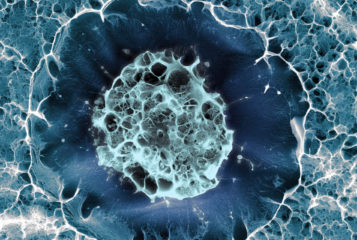After a mere 22 years of study, researchers in the Netherlands have finally pinpointed the genetic cause behind one type of hearing loss. This sounds potentially ground-breaking, so I was excited to learn more about the story in the 'Deafness Gene Identified' podcast, by The Naked Scientists.
I have heard great things about The Naked Scientists Podcast, which is the flagship, hour-long weekly science show from the group. This episode, which is from a spin off 'In Short' series, was my first introduction to the broadcasters and unfortunately, it left me feeling disappointed.
The idea of the 'In Short' series is to produce bite-sized nuggets of science news. The episodes are usually five minutes, and cover a single story. In most cases this works well, but in this particular episode, it left me with more questions than it answered.
The episode begins with the host explaining that the genetic cause of a certain type of adult-onset hearing lost has been identified - a defect in the RIPOR2 gene. The introduction was clear and concise and I was looking forward to hearing more. However, this was the only part of the podcast that stuck in my mind, and the rest of the episode was not so enjoyable.
The host, Eva Higginbotham, is clearly a great science communicator, and I think the downfall of this episode is that she did not cover more of the information herself. Instead, the bulk of this podcast comprises of interviews with two scientists who were involved in the study. Unfortunately, these interviews felt somewhat randomly edited together and cut off mid-sentence, at the end of the episode.
I liked that the first question Higginbotham poses to the geneticist who led the study – Professor Hannie Kremer, head of otogenetics research at Radboud University Medical Centre, The Netherlands – is, 'how did you go about finding this gene?' This gave Professor Kremer the opportunity to explain their research process, rather than just the end results. However, I felt that Professor Kremer focused too much on simplifying her explanations and they ended up being more convoluted and repetitive than necessary. In the end, I looked up the original research paper, published in the Journal of Medical Genetics in July of this year, to get better clarification.
From reading the paper, I learnt that unlike childhood-onset hearing loss, the genetic cause of adult-onset hearing loss is unknown, despite it being a highly heritable condition. The researchers hope that identifying the genetic cause will help them to develop better therapies for the condition.
We learn in the podcast that Professor Kremer and her colleagues went about this research by studying families who are affected by the type of hearing loss in question, which usually occurs at around 30 years old. They were able to identify 12 families where hearing loss was caused by a single genetic defect. Subsequently, they homed in on the region of one chromosome, and then the specific gene, that caused deafness. This turned out to be the RIPOR2 gene.
Professor Kremer explains that the RIPOR2 gene codes for a protein, and in people with the defect this protein ends up being shorter than it should be. This then means that the hair cells in the inner ear, which are crucial for our hearing, are less stable than in people who do not have the defect. Apparently, the mutation could be present in more than 30,000 people across NW Europe, so more people than previously thought are at risk of hearing loss.
The other interview included in the podcast is with Dr Ronald Pennings, who is an ear, nose and throat surgeon at Radboud University Medical Centre. Dr Pennings explains that the most common treatment for deafness caused by problems in the inner ear is to give the patient a hearing aid, which 'is not perfect'. Therefore, the discovery that the RIPOR2 gene is the cause, could lead to the development of genetic therapies targeting this gene. I would have been interested to know more about how this would be undertaken.
Overall, the impact and future directions of this study should have been emphasised more, because although the way it was conducted is interesting, for a short news podcast I think the potential impact is more exciting for listeners. Perhaps the aim of this particular episode was just too ambitious, and there was more information that could be satisfyingly conveyed to a non-specialist in the allotted five minutes.
Now that I have listened to more episodes from The Naked Scientists, I much prefer the longer episodes from their main podcast, but this could just be a matter of personal taste. The 'In Short' series is definitely worth trying if you are looking for short science news updates, as other episodes such as 'Genetic Risk for PTSD' do a great job of summarising new studies, and engaging the listeners.





Leave a Reply
You must be logged in to post a comment.